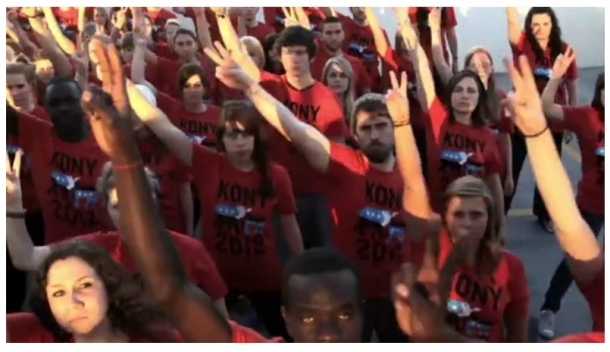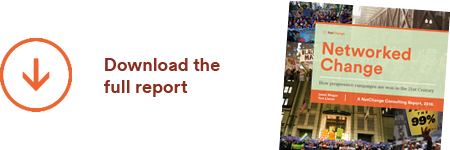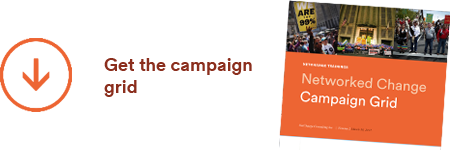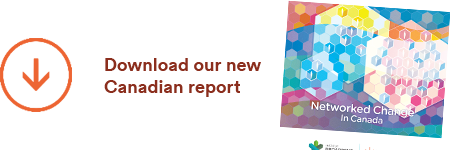There’s been a lot of ink spilled about the KONY 2012 video, the most successful cause video of all time (and most viral video ever). But I haven’t seen a lot of discussion around the campaign that surrounded the video, that is at least as responsible for its success. And while Invisible Children has faced controversy – in my opinion much more than they deserve – I’d rather turn this into a constructive dialogue on how other causes can learn from their incredible success.
In my view, most of the larger, more well known NGO’s won’t produce a communications piece this successful, unless they radically change their structures. Here are 6 reasons most NGO’s will never make a KONY, and some lessons we can take to improve our campaigns for this exciting new world.
1. You’ve never met your supporters
The founders of IC had spent the last 8 years actually meeting their supporters: presenting at about 3,000 events a year in schools and other hyper local gatherings, and starring in highly personal videos. Their presence and personal stories created a relationship, an emotional one, with audiences.
Say what you will about Jason Russell, but he’s clearly got a deep calling to do this work, and it’s infectious. So when he came back asking for help, supporters listened, and they cared.
No doubt your organization was founded by a passionate visionary who had a true calling, but most likely they are now long gone. Non-profits should unlock the staffers who are still driven by a deep personal mission to make change, and who speak eloquently to crowds. Build their profile and get them out of your office more, so that when you go asking for action, they pay attention.
2. You don’t really have a twitter army
Let’s face it. Your social media peeps largely followed you because it’s an easy way to stay lightly engaged in the issues you work on (that they typically care about more than your own brand). Other than a few exceptions, you’re not engaged in dialogue, you talk at them. A lot. About every big and obscure policy solution your org works on. You may not even have staff who are equipped or empowered to talk back.
IC is in a real relationship with its followers, responding to their questions, asking for help, giving them real things to do, and reporting back progress on what matters to them. They clearly respect their supporters. So when they asked for their help launching this campaign, they got on board, in spades. The person to person power of these social networks is what launched this video into the stratosphere, with the media eventually getting on board after it got huge online.
3. You speak to too many audiences
IC knew who its audience was, simply, American youth. It speaks in their language, using their cultural heros and influencers. Everything in KONY 2012 from the visuals (Facebook, hip posters) to the tone (hopeful, not dour or depressing) to the emotional hooks (kids, the power of people to tip the world, social media) speaks directly to this audience. Maybe this is one reason why it annoyed so many “institutional experts” over 40!
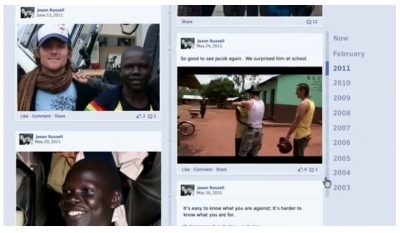 For good reasons, most non-profits have way too many diverse audiences, even in their own supporter bases, to ever speak so boldly. I honestly don’t know the solution to this other than to get to know audience segments more and target stronger communications at each segment, like politicians are so good at doing, which should be easier with modern CRM software and a little creativity.
For good reasons, most non-profits have way too many diverse audiences, even in their own supporter bases, to ever speak so boldly. I honestly don’t know the solution to this other than to get to know audience segments more and target stronger communications at each segment, like politicians are so good at doing, which should be easier with modern CRM software and a little creativity.
4. Your policy people would never let this get through
This is of course the #1 criticism of IC’s work, that they over-simplified (or manipulated) the issue, lacking nuance on the complexity of the situation. But the fact that they made this video for their audiences, not for their policy specialists, is the secret of their success.
Online cause video specialist Michael Hoffman said in Forbes.com: “the challenge that many of our (non-profit) clients have is that they aren’t willing to focus so narrowly on a single mission, to ‘dumb it down’ enough to have this kind of very clear and very narrow focus.” Those of us who work in non-profit communications know we’re the ugly step-children of the policy experts, who are the real power in the institution. We’re not typically able to “mess with the raw facts” to take bold positions like this.
What IC has really given its supporters is not information or policy precision, but hope and a crystal clear theory of change where individuals feel welcome contributing. If more of us truly believed in people-power and put more focus into serving their needs we would have much stronger, more engaged constituencies for our campaigns, not to mention friendlier media messages.
5. You run 18 campaigns & your site has 35 calls to action
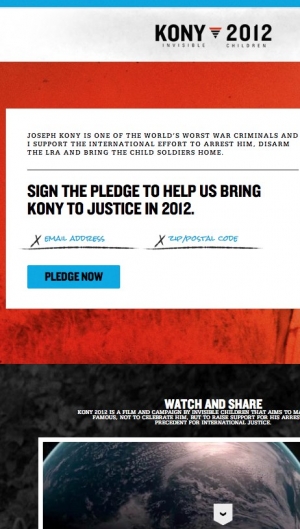 It’s a fact of life in most NGO’s there are multiple, often competing priorities, because there’s lots of work to be done. Groups like IC and even 350.org open themselves up to criticism by being so focused, however having such a clearly positioned brand is also how they are connecting with people in this busy, tuned out, over-complex world.
It’s a fact of life in most NGO’s there are multiple, often competing priorities, because there’s lots of work to be done. Groups like IC and even 350.org open themselves up to criticism by being so focused, however having such a clearly positioned brand is also how they are connecting with people in this busy, tuned out, over-complex world.
IC does pretty much one thing: raise awareness, which, let’s face it, most NGO’s are at best mediocre at. Should IC also be a policy shop and an aid agency, just because they work in Africa, as some of their critics suggest? Wouldn’t that dilute the one thing they are clearly really good at?
Their website is entirely focused around this ONE message and one action. Take a closer look, not only at its hip design, but the way the site funnels you to take that one action (view the video) then share it with your friends, then put pressure on policy and “culture makers”. Don’t let its simplicity fool you – a lot of thinking and UX planning went into a design this smart.
Non-profits can improve their action rates by first simplifying what they actually want supporters to do, and picking believable actions that may lead to something meaningful happening. People are smart, and if they don’t believe your theory of change, they won’t engage. And if you wear them out with one “crisis” after another, week after week, they tune out. Next, simplify your site, stripping down all actions or content that detracts from that core action. Then, focus all of your channels and messages on that one action. Report back progress. Repeat.
6. Your organization isn’t aligned towards the social web
This is probably the biggest reason most NGO’s won’t produce something as successful as the KONY video. “Network orgs” like IC tend to have similar attributes that are fundamentally different from how most NGO’s are structured and staffed:
- They specialize in doing one or two things incredibly well (typically not policy work)
- Everyone in the organization (or at least a critical mass) is aligned around their main goal or campaign. And everyone knows how to use the web to grow their movement
- Communications is a core capacity, it’s not seen as “not the real work” and doesn’t have to fight for resources
- People power lies at the core of their theory of change; it’s not an add on, it’s why they exist
- There are actions and support programs for the less engaged (clicks) medium engaged (often real-world events), and super-engaged (help us lead and campaign!)
- They are close to their supporters, asking what they want, constantly testing ideas with them, and sometimes even following their lead
Newish institutions such as Invisible Children (and their cousins in the for-profit world) are the ones driving the most innovation right now, and producing the game changing campaigns that are blowing all our minds. Love them or hate them, if you want to win like them, it’s wise to study some of the underlying structural and cultural frameworks they’re using to grow so quickly.
Jason Mogus is Communicopia’s principal consultant and is the founder of Web of Change. He has been developing digital strategies for social change organizations for over 15 years. You can follow him at @mogusmoves.

